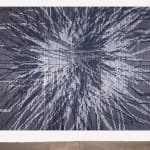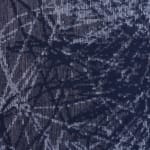Manish Nai India, b. 1980
Untitled, 2017
Natural and dyed jute cloth, gateway tracing paper and paint on canvas
99 1/2 x 124 1/2 in
252.7 x 316.2 cm
252.7 x 316.2 cm
6078
Further images
This painting by Manish Nai offers insight into the artists desire to express something inward looking out of the chaos of his surroundings. The work is made from recycled jute...
This painting by Manish Nai offers insight into the artists desire to express something inward looking out of the chaos of his surroundings. The work is made from recycled jute and paper, materials ubiquitous in Mumbai where Nai lives and works. The jute is dyed blue with indigo, another material intimately connected with India, past and present. Works such as this take Nai months, and sometimes years to produce. The materials are intricately compressed and layered in order to create compositions that at first, perhaps, might seem simple. The longer one spends with the work, the more complexities arise out of it. This, according to Nai, is an expression of the dichotomy of life in contemporary India, where activity, noise, and crowds are as essential to everyday life as a search for privacy, simplicity, and inner quietude.
Provenance
The artist's studio, Mumbai, IndiaKavi Gupta gallery, Chicago, IL USA







